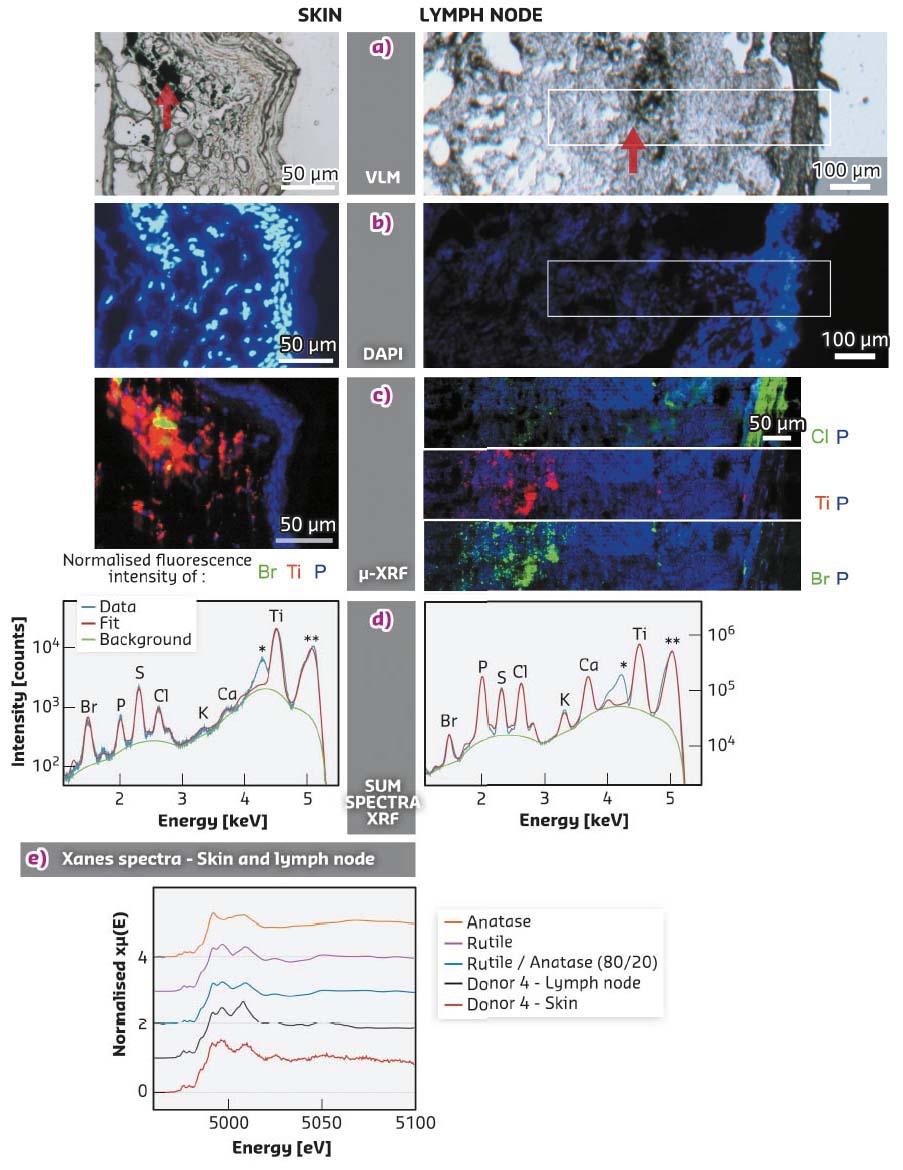- Home
- Users & Science
- Scientific Documentation
- ESRF Highlights
- ESRF Highlights 2017
- X-ray nanoprobe
- Micro- and nanoscale X-ray fluorescence imaging reveals fate and size of tattoo pigments in skin and lymph nodes
Micro- and nanoscale X-ray fluorescence imaging reveals fate and size of tattoo pigments in skin and lymph nodes
Highly sensitive X-ray fluorescence and spectroscopy methods facilitate simultaneous localisation and speciation of multiple tattoo pigment species, giving new insights on pigment distribution in the human body.
The increasing prevalence of tattoos leads to safety concerns with respect to particle distribution and effects inside the human body. Tattoos, as well as permanent make-up, work by depositing insoluble pigments into the dermal skin layer. In conjunction with tattoos, pigmented and enlarged lymph nodes have been noticed in tattooed individuals for years. Even though the observations leave little doubt about the origin of pigments, they have never been analytically investigated in human lymph nodes so far.
In animal studies, it has been shown that smaller particles are more easily distributed in the body. The average particle size in tattoo inks may vary from < 100 nm to > 1 µm. Therefore, most tattoo inks contain at least a small fraction of particles in the nano range. Next to the chemical identity of the pigments, the speciation of titanium dioxide (TiO2) white pigments was investigated. TiO2 is the second most commonly used pigment in tattoo inks. The toxicity of TiO2 depends on its speciation (crystal structure), which can be either rutile or the more harmful photocatalytically active anatase.
This work investigated skin and lymph tissues from human corpses to address local biokinetics by means of synchrotron X-ray fluorescence (XRF) techniques. To precisely locate the different tattoo and tissue related elements in the cutaneous and lymphatic tissue sections, micro-XRF was performed at ID21 at an energy of 5.05 keV. Additionally, Ti XANES (X-ray absorption near edge structure) spectra were collected, scanning the energy of the incoming beam from 4.95 to 5.1 keV at ID21 to provide information on TiO2 speciation. To assess primary particle sizes at the nanometric scale in particle mixtures, additional synchrotron-based nano X-ray fluorescence investigations were performed at ID16B with a pink beam of 17.5 keV.
Additional laboratory-based mass spectrometric methods demonstrated simultaneous transport of organic pigments, heavy metals and titanium from skin to regional lymph nodes. Laser desorption/ionisation mass spectrometry (LDI-MS) was used to identify organic pigments in skin and regional lymph nodes of the same donor. Inductively coupled plasma (ICP) MS was used to assess the general element load of the specimen investigated. However, these laboratory methods do not allow the localisation of the pigments in the tissues, the particle size assessment of multiple species at a time, nor the speciation of TiO2.
 |
|
Fig. 84: Micro-XRF mapping identifies and locates tattoo particle elements in skin and lymph node tissue sections. Sections of skin and lymph node tissue from donor 4 were analysed by means of synchrotron micro-XRF at ID21. a) Visible light microscopy (VLM) images of the area mapped by micro-XRF. Tattoo pigments are indicated by a red arrow. b) DAPI staining of adjacent sections showing the cell nuclei. c) micro-XRF maps of P, Ti, Cl and/or Br. For the lymph node, areas of similar size are marked in (a) and (b). d) Average micro-XRF spectra over the full area displayed in (c) * peak from sample support; ** scatter peak of the incoming beam. e) Ti K-edge micro-XANES spectra of skin and lymph node compared to transmission XANES spectra of reference material of rutile, anatase and an 80/20 rutile/anatase mixture calculation. |
In contrast, XRF-imaging at ID21 revealed co-localisation of Ti and Br in the dermal region of the skin (Figure 84). Ti XANES showed that Ti can be attributed to the white pigment TiO2 in the rutile crystal configuration (Figure 84). At ID16B, a broad range of tattoo pigment particles was found with up to several micrometres in size in human skin but only smaller than 200 nm particles in the lymph nodes (Figure 85). Among these compounds, the brominated organic green pigment displayed the broadest size range with smallest species preferentially reaching the lymph nodes.
 |
|
Fig. 85: Particle mapping and size distribution of different tattoo pigment elements. Skin and lymph node of donor 4 were analysed by means of synchrotron nano-XRF at ID16B. Log scale mappings of Ti, Br and Fe in the same areas in skin (a) and lymph node (b). |
With the detection of the same organic pigments and inorganic TiO2 in skin and lymph nodes, there is strong analytical evidence for the migration of pigments from the skin towards regional lymph nodes in humans upon tattooing. The outcome of these investigations will not only be helpful in the assessment of the health risks associated with tattooing, but can also help in the judgment of other exposure scenarios, such as the entrance of TiO2 nanoparticles present in cosmetics at the site of damaged skin or the wear-off from implant material.
Principal publication and authors
Synchrotron-based ν-XRF mapping and μ-FTIR microscopy enable to look into the fate and effects of tattoo pigments in human skin, I. Schreiver (a), B. Hesse (b), C. Seim (c), H. Castillo-Michel (b), J. Villanova (b), P. Laux (a), N. Dreiack (a), R. Penning (d), R. Tucoulou (b), M. Cotte (b) and A. Luch (a), Scientific Reports 7, 11395 (2017); doi: 10.1038/s41598-017-11721-z.
(a) German Federal Institute for Risk Assessment (BfR), Department of Chemical and Product Safety, Berlin (Germany)
(b) ESRF
(c) Physikalisch-Technische Bundesanstalt, Department of Temperature and Synchrotron Radiation, Berlin (Germany)
(d) Institute of Forensic Medicine, Ludwig-Maximilians University, Munich (Germany)



